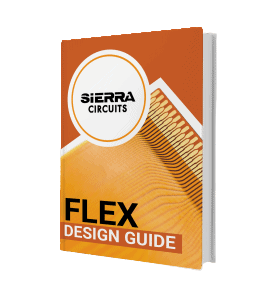Flex PCB Design Guide
The Sierra Circuits Flex PCB Design Guide helps you design highly flexible PCBs for electronics that move with you.
Unlike other boards and interconnects, flex circuits are lightweight, easy to install, durable, compact, and—yes—flexible. The range of motion can include over 360 degrees, making it the perfect choice for nearly any situation. You can use flexible circuits in “bend to install” or dynamic applications, where the circuits are continuously in motion. Flexible circuits are also advantageous for design packages where space is a primary concern.
The flex design guide helps you design flex and rigid-flex PCBs for all applications and covers:
- Calculating the bend radius
- Annular ring and via specifications
- Build your flex stack-up
- Controlled impedance for flex
- Fabrication and drawing requirements
The advantages of flex PCBs
Ease of use
- Design constraints are minimal. PCBs can be designed to fit any device shape.
- Range of motion allows boards to suit nearly any application.
- Less mass reduces risk in environments with regular vibrations.
- Reduces errors found in standard assemblies.
- Reduces weight through the elimination of additional wires, cables and connectors.
Reducing PCB size
- Thinner and more lightweight than their rigid alternatives.
- Durable against motion and bending.
- HDI allows for the miniaturization of devices.
Rigid-flex PCBs
- Blends flexible and rigid PCBs. Commonly formed with flexible circuits connecting several rigid flex boards.
HDI for flex
- Smaller package size increases the need of HDI.
- Allows additional space for other features on the PCB.
Cost reduction
- Total cost of installation is reduced.
- Flex circuits eliminate several steps within the production process, shortening overall turntime and reducing cost.
Also inside this Flex PCB Design Guide:
- The importance of the bend radius calculation
- How to increase flexibility in ground
- Manufacturing considerations for success





